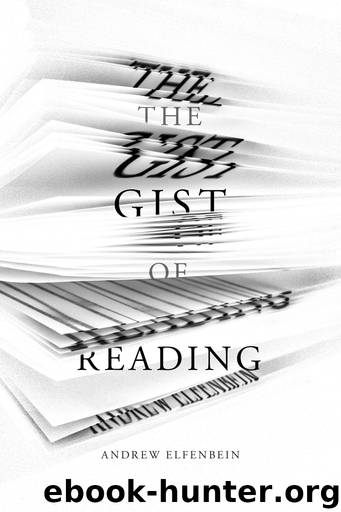The Gist of Reading by Elfenbein Andrew

Author:Elfenbein, Andrew [Elfenbein, Andrew]
Language: eng
Format: epub
Publisher: Stanford University Press
Published: 2017-03-18T04:00:00+00:00
CHAPTER 5
EASY READING
THE PREVIOUS CHAPTER traced hard reading as a social standard of coherence, arising from overlapping traditions in educational and religious writing. This tradition found a powerful base in the school, which made any form of reading that did not follow its standards look trivial, pointless, or slack. By the end of the nineteenth century, easy reading could look like intellectual suicide. One American writer notes that “fiction kills the appetite for wisdom and it gives nothing in its place. The reader has had the pleasure, the emotional experience, of the reading; but nothing of any value is left over. Useful reading requires brain-work. We can not expect to acquire knowledge without patient attention and careful thinking. The habit will gradually be formed of reading for profit, and then such reading will become a pleasure.”1 Such descriptions are typical of the heavy artillery aimed at light reading throughout the nineteenth century. Although often directed specifically at the female reader, denunciations of reading fiction were everywhere in the nineteenth century, and as such have received considerable attention from critics.
What has received less attention is that, outside of educational and religious settings, it is not easy to find evidence of ordinary readers who did what they were supposed to do. This absence could mean (1) evidence of readers’ hard reading has not survived; (2) such evidence does survive, but I have not found it; or (3) there is no evidence because they did not do it. Before searchable online databases it would have been difficult to decide among these. But on the basis of the evidence from databases, I believe that the third option is most probable because so many diverse reading experiences appear in them that we would expect to find at least some examples of independent hard reading.2 Its almost complete absence, while not conclusive, suggests that hard reading was a pedagogic ideal more than a lived reality, a model that readers may occasionally have approximated but that was too time-consuming to be practical in most cases. The automatized strategies of good-enough reading described in the first chapter were so useful, so often, that the incentive to surpass them was low. Much like contemporary Americans reading about diet and exercise, nineteenth-century audiences may have liked reading about what they should do more than they liked doing it. Endless denunciations of fiction enabled having one’s cake and eating it too: they satisfied a deep mistrust of fiction without stopping anyone from reading it.
Vigorously as educationalists disseminated hard reading, as I demonstrated in my discussion of Eliot’s Silas Marner, they were not the last word on reading. They competed with a different standard of coherence, which also had a long history, that presented reading in a different light and is the focus of this chapter. In this tradition, reading should be easy: if it is hard, something has gone wrong. The seventeenth-century theologian François de Fénelon offered a classic statement in his Dialogues on Eloquence (first translated into English in 1722
Download
This site does not store any files on its server. We only index and link to content provided by other sites. Please contact the content providers to delete copyright contents if any and email us, we'll remove relevant links or contents immediately.
4 3 2 1: A Novel by Paul Auster(12287)
The handmaid's tale by Margaret Atwood(7681)
Giovanni's Room by James Baldwin(7195)
Asking the Right Questions: A Guide to Critical Thinking by M. Neil Browne & Stuart M. Keeley(5649)
Big Magic: Creative Living Beyond Fear by Elizabeth Gilbert(5615)
Ego Is the Enemy by Ryan Holiday(5295)
The Body: A Guide for Occupants by Bill Bryson(4975)
On Writing A Memoir of the Craft by Stephen King(4863)
Ken Follett - World without end by Ken Follett(4646)
Adulting by Kelly Williams Brown(4488)
Bluets by Maggie Nelson(4476)
Eat That Frog! by Brian Tracy(4436)
Guilty Pleasures by Laurell K Hamilton(4362)
The Poetry of Pablo Neruda by Pablo Neruda(4041)
Alive: The Story of the Andes Survivors by Piers Paul Read(3970)
White Noise - A Novel by Don DeLillo(3954)
Fingerprints of the Gods by Graham Hancock(3943)
The Book of Joy by Dalai Lama(3903)
The Bookshop by Penelope Fitzgerald(3777)
